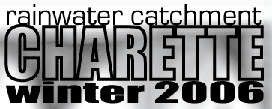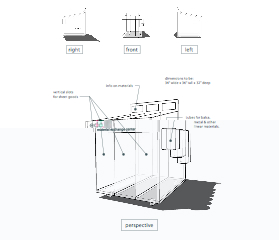rainwater catchment charrette
The EDC is helping to sponsor the Rainwater Catchment Charrette for the Lawrence Hall Courtyard, a student project organized by Jonathan Dunn and Nic Smith. Click the image at left to see the flyer. For more information contact Jonathan or Nic model materials exchange program
The model material exchange repository program will allow students to reuse modeling materials instead of having these materials go to waste. Currently and historically students have had few options in disposing of their scrap materials beyond throwing them away or putting them in the recycle bins. We hope this new program will encourage students to participate in the sustainable use of resources on a daily basis and also educate them about the lifecycle of these materials, while also reducing the waste stream of the AAA. We propose a system for students to GIVE & TAKE used modeling materials such as foam core, balsa, museum board, cardboard etc. The EDC will design model material exchange bins to be placed in proximity to the architecture studios. The students can voluntarily deposit and take the used materials within the model material exchange bins. click here to read the original proposal. solar projectabout the projectIn the spring of 2001, the ASUO requested proposals for a project to benefit the University of Oregon's student body. Offering a $100,000 grant to the student group with the most meaningful proposal, the competition attracted many submissions. The winning proposal, however, was the EDC's plan to install solar panels on the roof of the Erb Memorial Union, to generate renewable energy and revenue for the student body. In January of 2005, Phase Two of the Solar Project was completed when the 84-module photovoltaic array went online at the Student Rec Center. The final phase of the project is to build a kiosk in the Rec Center and a web site that will allow the public to monitor the power generated by the system. We expect to complete the kiosk and have the website online this fall. additional information
green curriculumThe EDC is working to further develop ecological design resources and opportunities at the University of Oregon. studio +This course is designed as a supplement to the regular design sequence, as a way to learn how to analyze and apply ecological design criteria to a design project. Strategies and tools to develop and evaluate sustainable design ideas will be the focus of the course. In particular, we will look at making substantial reductions in a building's energy use, arguably its most significant environmental impact. In the first part of the course (timed to coincide with most studio midterms), we will investigate climate, building program, and morphology. Students will learn how each of these elements affect and suggest strategies to decrease environmental impact. A studio-plus midterm pin-up will culiminate this section of the course, in which students will present their studio projects, alongside with their analysis from Studio Plus. In the second part of the course, we will focus on one specific sustainable technique. In the fall quarter, the emphasis is on daylighting. Students can expect to learn one or more methods for determining light levels, and assessing the appropriateness of daylighting techniques. A final pin-up, in which students will present their studio project and their related daylighting investigations, will be the final project for the course. As enrolled students will come from various studios, it is expected that workshop discussions and pin-ups will faciliate a peer-learning environment. Stduents will be able to see the ecological impacts of different climates, programs, and building morphologies. As well, students will be expected to share the results of their research and their conclusions with their entire studios. |

|
|
||
|
|

|
|
|
|
|
|||







